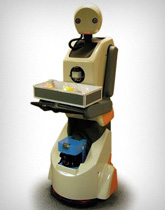The halls of your dorm are finally settling down in the predawn hours. You've been up late trying to finish that paper due tomorrow and could really use a break. Where are those cookies you ordered? Then you hear it, faintly at first, then getting louder. The strains of a familiar jingle coming closer and the whir of wheels rolling down the hallway.

And there he is at your door, announcing his greeting--a melodic "ooh eee." He's kind of like Disney Pixar's WALL-E, but he's carrying a butler's tray filled with cookies and other goodies. Round-camera-eyes peer up at you from an elliptical white head. His LED mouth flashes and he beep-boops again, a bit insistently. Oh, that's right—he's waiting for you to confirm your name so he can give you the yummy chocolate chips you ordered. You confirm with a "yes," and he nods his head toward the tray. You grab your cookie order, which is prepaid through your online account. Mid-bite into the chocolaty sweetness, you hear another polite "ooh eee." Oh yeah, he's waiting for you to send him on his way to the next customer. Unlike you at this moment, robots don't get sleepy.
Sounds farfetched? Don't tell Jodi Forlizzi, associate professor in Carnegie Mellon's Human-Computer Interaction Institute. She and her team are too busy setting "Snackbot" loose on campus in classroom buildings, with dorms in the not-too-distant future.
HCI Institute colleagues Forlizzi and Sara Kiesler, along with Paul Rybski of the Robotics Institute and Wayne Chung from the Design School, recently won a Microsoft Human-Robot Interaction award toward building Snackbot and studying how people modify their behavior when dealing with a social robot in a real-world setting. At any one time, between 10 and 15 students are also working with them—undergrads, PhD candidates, a number of them are international visitors. As Forlizzi puts it, "It's a real interdisciplinary and international collaboration."
Snackbot won't only be trying to spice up student life in the dorms and offices. He'll also be staking out space in public areas, like dorm lounges and campus eating locations. You won't be able to miss him. He won't let you. He loves attention and will be doing his robot dance and singing his version of the Carnegie Mellon alma mater, hoping you'll buy his snacks. And, Forlizzi says, he won't even expect a tip.
—Melissa Silmore (TPR'85)



